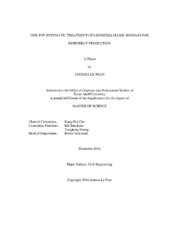One-Pot Enzymatic Treatment of Lignocellulosic Biomass for Bioenergy Production
Abstract
Bioenergy is a form of energy derived from renewable resources, such as lignocellulosic biomass. Lignocellulosic biomass refers to plant material. Many lignocellulosic biomasses considered as waste, such as agriculture waste, forest residues and municipal waste, can be valorized as biofuel. Added benefits from using these lignocellulosic biomasses include minimizing disposal cost and reducing overall greenhouse gas emission. Typical lignocellulosic biomass consists of approximately 40-50% cellulose, 25-30% hemicelluloses, and 15-25% lignin. The biomass is subjected to chemical or physical treatment and enzyme hydrolysis before the deconstructed sugar monomers are utilized for bioenergy production. Because of the tight structure and bonds between the three components of lignocellulosic biomass, physical or chemical treatment is required to swell the plant material to increase accessibility of the enzymes to the cellulose and hemicellulose. Chemical and physical treatments are energy intensive and have the potential to produce inhibitor compounds to reduce efficiency of biofuel production. Cellulose is the main component that is utilized for biofuel production, while hemicellulose and lignin are not depolymerized or utilized in biofuel production. This accounts for approximately 50% waste of biomass.
In this study, we explore the production of high crude lignocellulosic biomass depolymerizing enzymes for efficient deconstruction of lignocellulosic biomass. Specific objective of this study is to investigate complete enzyme deconstruction of lignocellulosic biomass in a single step process. LCD genes were cloned into expression vectors and transformed into Escherichia coli to produce crude enzymes. Crude cellulase, xylanase, and lignin peroxide were produced at 0.18 U/mL, 0.035 U/mL and 0.005 U/mL of activities. Crude cellulase and xylanase were demonstrated to deconstruct lignocellulosic biomass. This demonstrates that lignocellulosic biomass can be destructed to sugar monomers and lignin derivatives by crude enzymes produced by E. coli. The depolymerized lignocellulosic biomass can then be utilized by microorganisms to produce bioenergy or triacylglycerol, a precusor to biodiesel.
Subject
Lignocellulosic BiomassBiofuel
Bioenergy
Cellulose
Hemicellulose
Lignin
Cellulase
Xylanase
Lignin Peroxidase
Enzymatic Hydrolysis
Recombinant Protein
Cloning
Citation
Tran, Janessa Le (2016). One-Pot Enzymatic Treatment of Lignocellulosic Biomass for Bioenergy Production. Master's thesis, Texas A & M University. Available electronically from https : / /hdl .handle .net /1969 .1 /174264.


